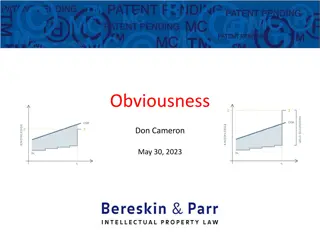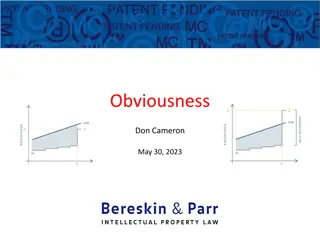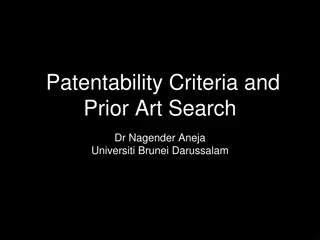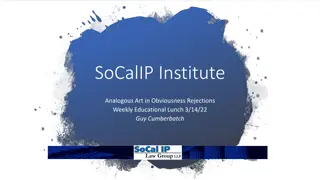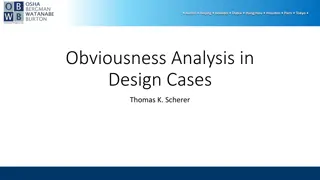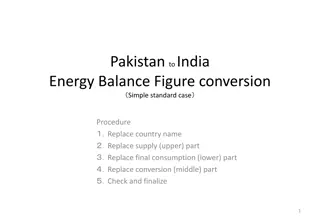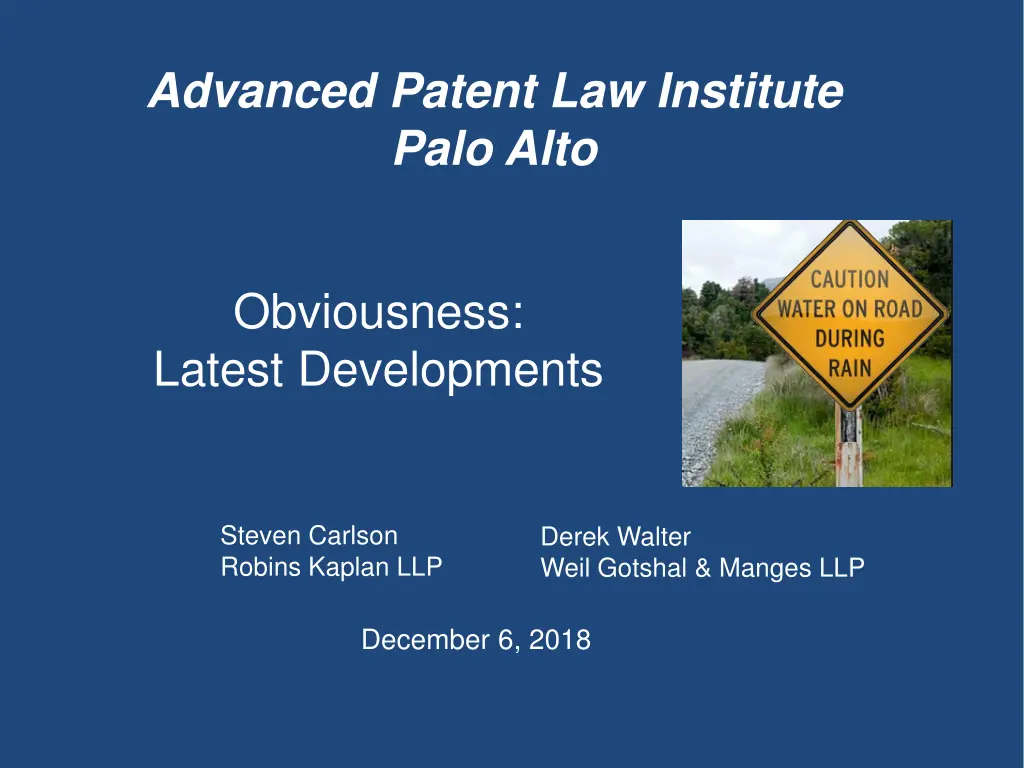
Latest Developments in Obviousness - Advanced Patent Law Institute Insights
Stay updated on the latest advances in patent law regarding obviousness with insights shared at the Advanced Patent Law Institute in Palo Alto. Topics covered include serial IPRs, broadest reasonable interpretation vs. Philips standard, restrictions in IPRs, and the use of secondary factors in IPRs.
Download Presentation

Please find below an Image/Link to download the presentation.
The content on the website is provided AS IS for your information and personal use only. It may not be sold, licensed, or shared on other websites without obtaining consent from the author. If you encounter any issues during the download, it is possible that the publisher has removed the file from their server.
You are allowed to download the files provided on this website for personal or commercial use, subject to the condition that they are used lawfully. All files are the property of their respective owners.
The content on the website is provided AS IS for your information and personal use only. It may not be sold, licensed, or shared on other websites without obtaining consent from the author.
E N D
Presentation Transcript
Advanced Patent Law Institute Palo Alto Obviousness: Latest Developments Steven Carlson Robins Kaplan LLP Derek Walter Weil Gotshal & Manges LLP December 6, 2018
Roadmap 1.Serial IPRs 2.Broadest Reasonable Interpretation v. Philips standard 3. Patent or Printed Publications Restriction in IPRs 4.Use of Secondary Factors in IPRs 2
Serial Petitions Is there a one bite at the apple rule at the PTAB? May the PTAB issue multiple written decisions on petitions by a party and/or its privies brought against the same claim? May the PTAB institute multiple IPRs on petitions by a party and/or its privies brought against the same claim? 4
Serial IPR Petitions: Statute The petitioner in an inter partes review of a claim in a patent under this chapter that results in a final written decision under section 318(a), or the real party in interest or privy of the petitioner, may not request or maintain a proceeding before the Office with respect to that claim on any ground that the petitioner raised or reasonably could have raised during that inter partes review. 35 U.S.C. 315(e)(1) 5
Serial Petitions: Statute Statute: a petition and/or its privies and other RPIs may not request or maintain a proceeding after the PTAB issues a final written determination on one of their petitions, as to an already-challenged claim Is the second proceeding a legal nullity? Does it matter if the proceedings are filed on the same day, or spaced out in time? Does it matter if the patent owner wins the first petition? 6
Serial Petitions: Statute Statute: the prohibition only applies to grounds that the petitioner raised or reasonably could have raised during that inter partes review Argument: If the petitioner had multiple arguments that did not all fit in the page limits for the first petition, then a second petition can be filed, because the additional grounds could not reasonably have been presented in the first petition. 7
Serial Petitions: Prevalence Percentage of petitions by Top 5 filers that overlap at least one claim of another petition filed by the same party -- the second column excludes the first proper petition Percentage Duplicate Petitions (counting all) Percentage Duplicate Petitions (excluding first petition) 34 Apple 56 Microsoft 59 37 Samsung 38 24 Google 38 22 LG 34 18 Source: Carlson & Schultz, Tallying Repetitive IPR Petitions, IP Law360, 9/14/18; see also Berta & Reidy, Multiple IPR Petitions for Same Claim Are Often Not Repetitive, IP Law360, 11/16/18 8
Serial Petitions: General Plastics Updated Trial Practice Guide (August 2018) features guidance on instituting overlapping petitions: General Plastic Industrial v. Canon Kabushiki Kaisha, IPR2016-01357 (precedential) 9
Serial Petitions: SAS angle Once instituted, [petitioner] is entitled to a final written decision addressing all of the claims it has challenged SAS Institute, Inc. v. Iancu, 138 S.Ct. 1348, 1359 (2018) So .: 1) if the petitioner may not maintain an IPR on a claim after a first FWD, and 2) the PTAB must issue a FWD if it institutes an IPR, then 3) Should the PTAB be instituting overlapping petitions? Practice tip: protect yourself! 10
Broadest Reasonable Interpretation (BRI) v. Philips
November IPR Filings 11/12/18 12
BRI v. Phillips During reexamination, as with original examination, the PTO must give claims their broadest reasonable construction consistent with the specification. Therefore, we look to the specification to see if it provides a definition for claim terms, but otherwise apply a broad interpretation. As this court has discussed, this methodology produces claims with only justifiable breadth. In re ICON Health & Fitness, Inc., 496 F.3d 1374, 1379 (Fed. Cir. 2007) 13
BRI v. Phillips Under a broadest reasonable interpretation, words of the claim must be given their plain meaning, unless such meaning is inconsistent with the specification and prosecution history. Trivascular, Inc. v. Samuels, 812 F.3d 1056, 1062 (Fed. Cir. 2016) 14
Strategic Considerations In an inter partes review proceeding, a claim of a patent, or a claim proposed in a motion to amend under 42.121, shall be construed using the same claim construction standard that would be used to construe the claim in a civil action under 35 U.S.C. 282(b), including construing the claim in accordance with the ordinary and customary meaning of such claim as understood by one of ordinary skill in the art and the prosecution history pertaining to the patent. Any prior claim construction determination concerning a term of the claim in a civil action, or a proceeding before the International Trade Commission, that is timely made of record in the inter partes review proceeding will be considered. 37 C.F.R. 42.100(b) 15
Strategic Considerations Increased need for consistency between district court and PTAB positions - Collateral estoppel - Judicial estoppel Petitioners must commit to a claim construction within one year after complaint is filed Greater role for IPR record as prosecution history in claim construction Increased district court stay likelihood Consider ex partes reexamination if claim construction standard is critical 16
IPRs: Patents or Printed Publications Restriction District Court Any ground of invalidity permitted IPR ( Second Window ) A petitioner in an inter partes review may request to cancel as unpatentable 1 or more claims of a patent only on a ground that could be raised under section 102 or 103 and only on the basis of prior art consisting of patents or printed publications PGR ( First Window ) Any ground of invalidity permitted 18
AIA: Legislative History In this bill, however, the issues that can be raised in the second window are so sharply limited that the goal of flushing out all claims is unattainable. Only 102 and 103 arguments based on patents and printed publications can be raised in the second window. Accused infringers inevitably will have other challenges and defenses that they will want to bring, and those arguments can only be raised in district court. Senator Kyl Speech on S 3600, 154 Cong. Rec. S9982-S9993, at S9989 (Sept. 27, 2008). 19
Patents or Printed Publications Restriction In IPRs, must the prima facie case of obviousness be established in patents or printed publications? 20
KSR Factors Under KSR, a wide-ranging list of factors may be considered that are based in matters external to the submitted prior art. These include: (A) Combining prior art elements according to known methods to yield predictable results; (B) Simple substitution of one known element for another to obtain predictable results; (C) Use of known technique to improve similar devices (methods, or products) in the same way; (D) Applying a known technique to a known device (method, or product) ready for improvement to yield predictable results; (E) Obvious to try choosing from a finite number of identified, predictable solutions, with a reasonable expectation of success; (F) Known work in one field of endeavor may prompt variations of it for use in either the same field or a different one based on design incentives or other market forces if the variations are predictable to one of ordinary skill in the art; (G) Some teaching, suggestion, or motivation in the prior art that would have led one of ordinary skill to modify the prior art reference or to combine prior art reference teachings to arrive at the claimed invention. Question: Are all these KSR factors proper in limited IPR review? 21
IPR Statistics: Multi-Reference Invalidity Rulings Study: Percentage of multi-reference invalidity rulings supported by an express TSM in the submitted prior art: approximately 33% Sample: 20 most recent rulings issued on petitions to each of the Top 5 filers (Apple, Samsung, Google, Microsoft, LG) (100 total) (data available on request) Question: can the prima facie case of obviousness be established by relying on evidence external to the patents or printed publications? -- i.e., non-TSM KSR factors (e.g., obvious to try )? Practice tip: protect yourself! 22
Graham Factors Scope and contents of the art Differences between the prior art and the claims at issue Level of ordinary skill in the art Objective indicia of obviousness 24
Law: Obviousness With Integrated Objective Indicia A determination of whether a patent claim is invalid as obvious under 103 requires consideration of all four Graham factors, and it is error to reach a conclusion of obviousness until all those factors are considered. Objective indicia of nonobviousness must be considered in every case where present. Apple Inc. v. Samsung Electronics Co., Ltd., 839 F. 3d 1034, 1048 (Fed. Cir. 2016) (en banc) 25
Law: Obviousness With Integrated Objective Indicia Indeed, evidence of secondary considerations may often be the most probative and cogent evidence in the record. It may often establish that an invention appearing to have been obvious in light of the prior art was not. It is to be considered as part of all the evidence, not just when the decision maker remains in doubt after reviewing the art. Stratoflex, Inc. v. Aeroquip Corp., 713 F. 2d 1530, 1538-39 (Fed. Cir. 1983) 26
Graham Factors Scope and contents of the art Differences between the prior art and the claims at issue Level of ordinary skill in the art Objective indicia of obviousness 27
Obviousness With Decoupled Objective Indicia In any event, as with the evidence of commercial success, the district court found that the evidence of copying could not overcome the weight of the competing evidence of obviousness of the claimed process. We agree with the district court. The claimed process differs from the disclosure of the '323 patent only in routine details, the implementation of which would have been well within the capabilities of one of ordinary skill in the art. Merck Sharp & Dohme Corp. v. Hospira, Inc., 874 F. 3d 724, 731 (Fed. Cir. 2017) 28
Obviousness With Decoupled Objective Indicia It is time to remedy our inconsistent treatment of the procedures and burdens in applying the evidentiary factors of obviousness, despite the clarifying precedent in Graham v. John Deere Co., 383 U.S. 1, 86 S.Ct. 684, 15 L.Ed.2d 545 (1966). The Court in Graham resolved prior inconsistencies and established what was seen as a wiser standard of obviousness. The Court established the factual premises and fixed the placement of the burdens. It is time to restore this salutary rigor. Merck Sharp & Dohme Corp. v. Hospira, Inc., 874 F.3d 724, 731 (Fed. Cir. 2017) (Newman, J. dissenting) 29
Law: Objective Indicia Of Obviousness The legal questions I see here include (1) whether an obviousness analysis involving secondary considerations (or objective indicia of non-obviousness) is a one- or two-step process and (2) how much weight to accord secondary considerations in the obviousness analysis. Apple Inc. v. Samsung Electronics Co., Ltd., 839 F. 3d 1034, 1089 (Fed. Cir. 2016) (en banc) (Reyna, J., Dissenting) 30
Obviousness With Decoupled Objective Indicia KSR and Graham assigned a limited role to secondary considerations . Before Graham, the Supreme Court repeatedly held that courts should give secondary considerations limited weight in the ultimate legal determination of obviousness and that the courts need not consider them where the claimed invention represents a small advance and there is a strong case for obviousness. Apple Inc. v. Samsung Elecs. Co., 839 F.3d 1034, 1081 (Fed. Cir. 2016) (Dyk, J. dissenting) 31
Showing Nexus Copying Licensing often not given substantial weight Commercial Success expert testimony re: embodying products Industry praise connection to invention, not correlation Skepticism connection to invention, not correlation Long felt need connection to invention, not correlation 34



